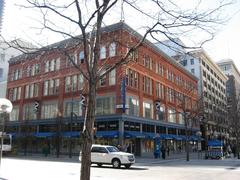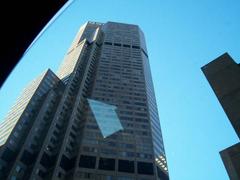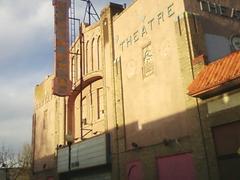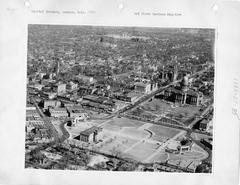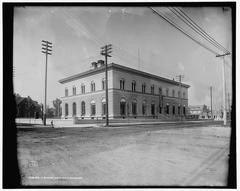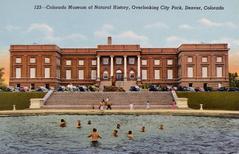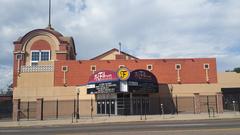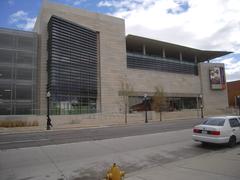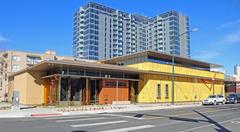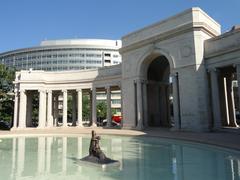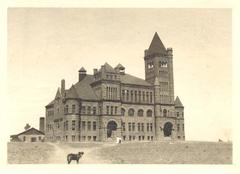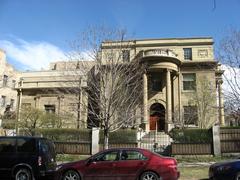
Sunken Gardens Park Denver: Visiting Hours, Tickets, and Historical Sites Guide
Date: 03/07/2025
Introduction
Sunken Gardens Park in Denver, Colorado, is a 12.5-acre urban sanctuary blending historical landscape design, cultural heritage, and tranquil green space. Located at the intersection of Speer Boulevard and 8th Avenue, the park is a testament to Denver’s City Beautiful movement and remains a vibrant hub for community gatherings, public art, and natural beauty. Whether you’re a history buff, nature lover, or local resident, this comprehensive guide covers everything you need to know—visiting hours, amenities, history, accessibility, nearby attractions, and insider tips to help you make the most of your visit.
Table of Contents
- Historical Overview
- Practical Visitor Information
- Park Features and Amenities
- Cultural and Urban Significance
- Environmental and Economic Impact
- Nearby Attractions
- Frequently Asked Questions (FAQ)
- Visitor Tips
- Visuals and Media
- Summary and Call to Action
- References
Historical Overview
Early Origins and Design (1909–1911)
Sunken Gardens Park was established during the City Beautiful movement, which aimed to enhance urban spaces with grand, orderly parks. Designed by George Kessler and Saco R. DeBoer between 1909 and 1911, the park transformed a former dumping site into a terraced “sunken” garden. The original plan featured a dual-triangle layout, informal forested areas, and a formal garden inspired by manor estates, reflecting the era’s emphasis on blending natural and urban elements (History Colorado; Uncover Colorado).
Architectural Features and Enhancements
Key early features included a Moorish-style pavilion by Jules Jacques Benoit Benedict (1912), floral beds, a reflecting pool, and a decorative drinking fountain. While some elements—like the pavilion and the reflecting pool—were later removed, remnants are visible today and form part of the park’s historical narrative (City Cast Denver; The Cultural Landscape Foundation).
Evolution and Preservation
Over time, changes in public health policy and recreation trends led to the loss of some original features (e.g., the pool was filled in due to polio concerns). However, the park’s open lawns, mature trees, and rock garden endure, maintaining its historical character. In 1986, Sunken Gardens Park was listed on both the National Register of Historic Places and the Colorado State Register of Historic Properties (History Colorado; The Cultural Landscape Foundation).
Recent master planning efforts have focused on restoration, interpretive signage, and community engagement, ensuring the park’s legacy remains vibrant and accessible (Denver Parks and Recreation Master Plan, 2021).
Practical Visitor Information
Visiting Hours and Admission
- Hours: Daily, dawn to dusk (typically 5:00 am – 11:00 pm in line with Denver parks)
- Admission: Free; no tickets required
Accessibility
- ADA-compliant entrances and wide, paved paths accommodate wheelchairs, strollers, and bikes.
- Accessible restrooms and picnic areas are available.
Transportation and Parking
- Location: 8th Avenue and Speer Boulevard, central Denver
- Public Transit: Multiple RTD bus lines and nearby light rail stations serve the area.
- Parking: Free on-site parking with additional street spaces; public transit is recommended during busy periods (Wild Roots Garden).
Best Times to Visit
- Seasons: Spring through fall for vibrant gardens and mild weather.
- Timing: Early mornings and weekdays for a quieter atmosphere; weekends for events and gatherings.
Park Features and Amenities
Terraced Design and Layout
The park’s defining feature is its sunken, terraced layout, creating a natural amphitheater effect. Stone steps and embankments frame the central lawns, offering multiple vantage points and secluded spots for relaxation (Wild Roots Garden).
- Entrances: Main access at 8th Avenue and Speer Boulevard
- Main Loop: ~0.6-mile paved walking trail (Hiiker)
- Central Sunken Area: Surrounded by gardens and water features
- Open Lawns: For recreation and gatherings
Gardens, Lawns, and Water Features
- Botanical Diversity: Seasonal flower beds, mature shade trees (maples, oaks, elms), and pollinator-friendly plantings
- Water Elements: Reflective pools and small fountains add tranquility and visual interest
- Seating: Benches, shaded areas, and picnic tables throughout
Community Events and Public Art
- Events: The park hosts art exhibits, seasonal festivals, yoga classes, and educational workshops (Denver Parks Events).
- Public Art: Rotating installations and murals reflect Denver’s multicultural heritage (Wild Roots Garden).
Cultural and Urban Significance
City Beautiful Movement Legacy
Sunken Gardens Park is a living example of early 20th-century urban planning ideals—elevating public spaces with beauty and function. Its preservation affirms Denver’s commitment to green, inclusive cityscapes (wildrootsgarden.com).
El Movimiento and Social Impact
During the 1960s–70s, the park became a vital gathering place for the Chicano civil rights movement, El Movimiento, particularly due to its proximity to West High School. Today, this legacy is honored through cultural programming and community events (Nextdoor).
Community Engagement and Revitalization
Recent master plans, developed with extensive community input, focus on inclusivity, accessibility, and restoring lost features. Key projects include a planned Cultural Community Center, enhanced event spaces, and nature play areas for children (Denver Parks and Recreation Master Plan, 2021).
Environmental and Economic Impact
- Urban Green Space: The park improves air quality, mitigates urban heat, and supports local wildlife (Wild Roots Garden).
- Sustainability: Features native, drought-tolerant plantings and efficient irrigation.
- Economic Value: Revitalization has boosted nearby property values, supported local businesses, and created event-driven economic activity (Nextdoor).
Nearby Attractions
- Denver Art Museum: Renowned for diverse collections, a short walk away
- Art District on Santa Fe: Galleries, shops, and eateries
- West High School: Historic site of Chicano activism
- Denver Botanic Gardens and Civic Center Park: Additional urban green spaces (Exploding Travel)
Frequently Asked Questions (FAQ)
Q: What are the park hours?
A: Open daily from dawn to dusk (5:00 am – 11:00 pm).
Q: Is there an entrance fee?
A: No, the park is free for all visitors.
Q: Is the park accessible for people with disabilities?
A: Yes, with ADA-compliant paths and entrances.
Q: Are dogs allowed?
A: Yes, dogs are welcome but must be on a leash.
Q: What amenities are available?
A: Restrooms, drinking fountains, benches, and shaded seating.
Q: Are there guided tours or events?
A: Yes, check Denver Parks Events for schedules.
Visitor Tips
- Pack a Picnic: Enjoy the open lawns and shaded areas.
- Stay Hydrated: Denver’s altitude can be dehydrating—bring water.
- Best Photography: Capture the park at golden hour for optimal light.
- Be Aware: Exercise standard urban safety, especially after dark.
- Combine Your Visit: Pair with nearby museums or a city walk.
Visuals and Media
Enhance your experience with high-quality images of the terraced gardens, water features, and art installations. Use alt tags like “Sunken Gardens Park terraced gardens in Denver” or “Sunken Gardens Park panoramic city skyline view” for improved accessibility and SEO.
Consider embedding an interactive map and virtual tour if available.
Summary and Call to Action
Sunken Gardens Park remains a cherished oasis in Denver, celebrated for its historical depth, vibrant community role, and restorative green space. Its accessibility, central location, and diverse amenities make it a must-visit for residents and travelers alike. With ongoing revitalization and community engagement, the park’s future is bright—preserving its legacy while evolving to serve new generations (History Colorado; Denver Parks and Recreation Master Plan, 2021).
Plan your visit today and discover the legacy, tranquility, and beauty of Sunken Gardens Park. Download the Audiala app for guided tours, event updates, and exclusive content about Denver’s top attractions. Follow us on social media for the latest news and visitor tips!
References
- History Colorado
- Uncover Colorado
- The Cultural Landscape Foundation
- Denver Parks and Recreation Master Plan, 2021
- Nextdoor
- Wild Roots Garden
- Wild Roots Garden - Visiting Hours, Tickets, and Attractions
- Hiiker
- City Cast Denver
- Exploding Travel

